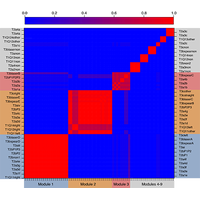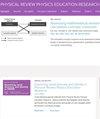折射背景下符号表征与学生成绩之间的关系
IF 2.6
2区 教育学
Q1 EDUCATION & EDUCATIONAL RESEARCH
Physical Review Physics Education Research
Pub Date : 2024-02-05
DOI:10.1103/physrevphyseducres.20.010103
引用次数: 0
摘要
关于表征在物理等领域的有效教学中所扮演角色的社会符号学讨论,已经提出了一些理论建议,这些建议有一个很强的共同点:为了获得对特定学习对象的适当理解,获取所使用表征的学科相关性方面,需要在系统使用的符号资源的特定关键组合(被称为模式,详见下文)中获得表征能力。然而,对于特定学习对象与不同表征形式之间的关系,特别是针对大量学生的表征形式,文献中缺乏肯定性的实证调查,尤其是在大学物理教育的背景下。为了着手解决这一研究不足,本文的定位是,此类研究需要包含学生思维和知识应用的复杂性。为此,本文采用了因素分析和网络分析两种方法。尽管这两种方法基于不同的框架,但就当前的任务而言,这两种方法都有助于分析大量参与者反应中的聚类动态。这两种方法还有助于探索这些聚类与表征的符号资源表述之间的关系。这些数据来自一份调查问卷,调查对象是来自 7 个国家 12 所大学的 1368 名学生。问卷涉及入门级物理学中的光折射问题,要求学生对不同符号构成情境中图像和物体的相对视觉定位做出最佳预测。这两种方法的结果都表明,特定的表述方式与特定的学生回答群之间没有一一对应的关系。因子分析使用正确答案来揭示与表象表述相关的三种不同复杂程度的群组。网络分析使用所有答案(正确的和不正确的)来揭示三种结构模式。从这两项分析的结果中可以明显看出,它们证实了社会符号学探索中出现的两个广泛结论,即表征与试图优化教学的关系。第一个结论与 "促进意识 "观点有关,即任何特定的学科视觉表征都会唤起一系列分散的知识结构,这被称为其相关性结构。因此,可以认为网络分析结果为旨在确定这种相关性结构的研究提供了一个独特的起点。第二个广泛的结论是,学科视觉表征可以而且往往包含比特定表征直接可见的更多学科相关方面。这些方面被称为 "表象"(appresent),需要成为人们构成预期意义所需的总体意识的一部分。因此,因子分析的结果也可以被视为一种捕捉所有学科相关方面(存在和表征)的方法。本文讨论了其教育意义。本文章由计算机程序翻译,如有差异,请以英文原文为准。

Relationship between semiotic representations and student performance in the context of refraction
Social semiotic discussions about the role played by representations in effective teaching and learning in areas such as physics have led to theoretical proposals that have a strong common thread: in order to acquire an appropriate understanding of a particular object of learning, access to the disciplinary relevance aspects in the representations used calls for the attainment of representational competence across a particular critical constellation of systematically used semiotic resources (which are referred to as modes, see more on this later). However, an affirming empirical investigation into the relationship between a particular object of learning and different representational formulations, particularly with large numbers of students, is missing in the literature, especially in the context of university-level physics education. To start to address, this research shortfall the positioning for this article is that such studies need to embrace the complexities of student thinking and application of knowledge. To achieve this, both factor and network analyses were used. Even though both approaches are grounded in different frameworks, for the task at hand, both approaches are useful for analyzing clustering dynamics within the responses of a large number of participants. Both also facilitate an exploration of how such clusters may relate to the semiotic resource formulation of a representation. The data were obtained from a questionnaire given to 1368 students drawn from 12 universities across 7 countries. The questionnaire deals with the refraction of light in introductory-level physics and involves asking students to give their best prediction of the relative visual positioning of images and objects in different semiotically constituted situations. The results of both approaches revealed no one-to-one relationship between a particular representational formulation and a particular cluster of student responses. The factor analysis used correct answer responses to reveal clusters that brought to the fore three different complexity levels in relation to representation formulation. The network analysis used all responses (correct and incorrect) to reveal three structural patterns. What is evident from the results of both analyses is that they confirm two broad conclusions that have emerged from social semiotic explorations dealing with representations in relation to attempting to optimize teaching and learning. The first, which is linked to a facilitating-awareness perspective, is that any given disciplinary visual representation can be expected to evoke a dispersed set of knowledge structures, which is referred to as their relevance structure. Thus, the network analysis results can be seen as presenting a unique starting point for studies aiming to identify such relevance structure. The second broad conclusion is that disciplinary visual representation can and often does contain more disciplinary-relevant aspects than what may be directly visible in a given representation. These are referred to as the appresent aspects that need to become part of the total awareness needed by someone to constitute an intended meaning. The results of the factor analysis can then also be seen to be a way of capturing all the disciplinary-relevant aspects (both present and appresent). Educational implications are discussed.
求助全文
通过发布文献求助,成功后即可免费获取论文全文。
去求助
来源期刊

Physical Review Physics Education Research
Social Sciences-Education
CiteScore
5.70
自引率
41.90%
发文量
84
审稿时长
32 weeks
期刊介绍:
PRPER covers all educational levels, from elementary through graduate education. All topics in experimental and theoretical physics education research are accepted, including, but not limited to:
Educational policy
Instructional strategies, and materials development
Research methodology
Epistemology, attitudes, and beliefs
Learning environment
Scientific reasoning and problem solving
Diversity and inclusion
Learning theory
Student participation
Faculty and teacher professional development
 求助内容:
求助内容: 应助结果提醒方式:
应助结果提醒方式:


